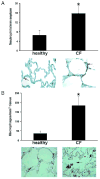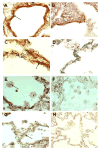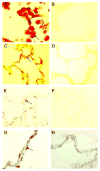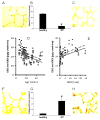Alveolar inflammation in cystic fibrosis
- PMID: 20347403
- PMCID: PMC2883667
- DOI: 10.1016/j.jcf.2010.03.001
Alveolar inflammation in cystic fibrosis
Abstract
Background: In infected lungs of the cystic fibrosis (CF) patients, opportunistic pathogens and mutated cystic fibrosis transmembrane conductance regulator protein (CFTR) contribute to chronic airway inflammation that is characterized by neutrophil/macrophage infiltration, cytokine release and ceramide accumulation. We sought to investigate CF lung inflammation in the alveoli.
Methods: Lung tissue from 14 CF patients and four healthy individuals was analyzed for numbers of effector cells, elastin and collagen concentrations, inflammatory markers and density of Pseudomonas aeruginosa. Additionally, desmosine and isodesmosine concentrations were determined in 52 urine specimens from CF patients to estimate the burden of elastase activities in respiratory secretions.
Results: Elastin concentration was significantly decreased and collagen significantly increased in CF alveolar tissues as compared to age-matched, healthy individuals. Elastin split products were significantly increased in urine samples from patients with CF and correlated inversely with age, indicating local tissue remodelling due to elastin degradation by unopposed proteolytic enzymes. Alveolar inflammation was also characterized by a significant cell infiltration of neutrophils, macrophages and T cells, extensive nuclear factor-kappaB and insulin-like growth factor-1 activation in various cell types and increased intercellular adhesion molecule-1 expression, and increased numbers of myofibroblasts. Additionally, ceramide accumulated in type II alveolar epithelial cells, lacking CFTR. P. aeruginosa organisms were rarely present in inflamed alveoli.
Conclusions: Chronic inflammation and remodeling is present in alveolar tissues of the CF lung and needs to be addressed by anti-inflammatory therapies.
Figures







Similar articles
-
Elastin and collagen degradation products in urine of patients with cystic fibrosis.Am J Respir Crit Care Med. 1995 Jul;152(1):157-62. doi: 10.1164/ajrccm.152.1.7599816. Am J Respir Crit Care Med. 1995. PMID: 7599816
-
Urinary desmosine: a biomarker of structural lung injury during CF pulmonary exacerbation.Pediatr Pulmonol. 2012 Sep;47(9):856-63. doi: 10.1002/ppul.22525. Epub 2012 Mar 19. Pediatr Pulmonol. 2012. PMID: 22431382 Free PMC article.
-
MEKC of desmosine and isodesmosine in urine of chronic destructive lung disease patients.Eur Respir J. 2000 Jun;15(6):1039-45. doi: 10.1034/j.1399-3003.2000.01511.x. Eur Respir J. 2000. PMID: 10885422
-
Harnessing Neutrophil Survival Mechanisms during Chronic Infection by Pseudomonas aeruginosa: Novel Therapeutic Targets to Dampen Inflammation in Cystic Fibrosis.Front Cell Infect Microbiol. 2017 Jun 30;7:243. doi: 10.3389/fcimb.2017.00243. eCollection 2017. Front Cell Infect Microbiol. 2017. PMID: 28713772 Free PMC article. Review.
-
Mouse models of chronic lung infection with Pseudomonas aeruginosa: models for the study of cystic fibrosis.Pediatr Pulmonol. 2000 Nov;30(5):413-24. doi: 10.1002/1099-0496(200011)30:5<413::aid-ppul8>3.0.co;2-9. Pediatr Pulmonol. 2000. PMID: 11064433 Review.
Cited by
-
Hematopoietic and mesenchymal stem cells for the treatment of chronic respiratory diseases: role of plasticity and heterogeneity.ScientificWorldJournal. 2014 Jan 19;2014:859817. doi: 10.1155/2014/859817. eCollection 2014. ScientificWorldJournal. 2014. PMID: 24563632 Free PMC article. Review.
-
Nano-based theranostics for chronic obstructive lung diseases: challenges and therapeutic potential.Expert Opin Drug Deliv. 2011 Sep;8(9):1105-9. doi: 10.1517/17425247.2011.597381. Epub 2011 Jun 28. Expert Opin Drug Deliv. 2011. PMID: 21711085 Free PMC article.
-
Identification of molecular signatures of cystic fibrosis disease status with plasma-based functional genomics.Physiol Genomics. 2019 Jan 1;51(1):27-41. doi: 10.1152/physiolgenomics.00109.2018. Epub 2018 Dec 12. Physiol Genomics. 2019. PMID: 30540547 Free PMC article.
-
DMBT1 is upregulated in cystic fibrosis, affects ciliary motility, and is reduced by acetylcysteine.Mol Cell Pediatr. 2022 Mar 5;9(1):4. doi: 10.1186/s40348-022-00136-0. Mol Cell Pediatr. 2022. PMID: 35249163 Free PMC article.
-
Pneumocystis jirovecii in Patients With Cystic Fibrosis: A Review.Front Cell Infect Microbiol. 2020 Sep 29;10:571253. doi: 10.3389/fcimb.2020.571253. eCollection 2020. Front Cell Infect Microbiol. 2020. PMID: 33117730 Free PMC article. Review.
References
-
- Rommens JM, Iannuzzi MC, Kerem B, Drumm ML, Melmer G, Dean M, Rozmahel R, Cole JL, Kennedy D, Hidaka N, Zsiga M, Buchwald M, Riordan JR, Tsui LC, Collins F. Identification of the cystic fibrosis gene: chromosome walking and jumping. Science. 1989;245:1059–65. - PubMed
-
- Riordan JR, Rommens JM, Kerem B, Alon N, Rozmahel R, Grzelczak Z, Zielenski J, Lok S, Plavsic N, Chou JL, Drumm ML, Iannuzzu MC, Collins FS, Tsui LC. Identification of the cystic fibrosis gene: cloning and characterization of complementary DNA. Science. 1989;245:1066–73. - PubMed
-
- Kerem B, Rommens JM, Buchanan JA, Markiewicz D, Cox TK, Chakravarti A, Buchwald M, Tsui LC. Identification of the cystic fibrosis gene: genetic analysis. Science. 1989;245:1073–80. - PubMed
-
- Boucher RC. New concepts of the pathogenesis of cystic fibrosis lung disease. Eur Respir J. 2004;23:146–58. - PubMed
-
- Worlitzsch D, Tarran R, Ulrich M, Schwab U, Cekici A, Meyer KC, Birrer P, Bellon G, Berger J, Weiß T, Botzenhart K, Yankaskas JR, Randell S, Boucher RC, Döring G. Reduced oxygen concentrations in airway mucus contribute to the early and late pathogenesis of Pseudomonas aeruginosa cystic fibrosis airways infection. J Clin Invest. 2002;109:295–09. - PMC - PubMed
MeSH terms
Substances
Grants and funding
LinkOut - more resources
Full Text Sources
Medical

